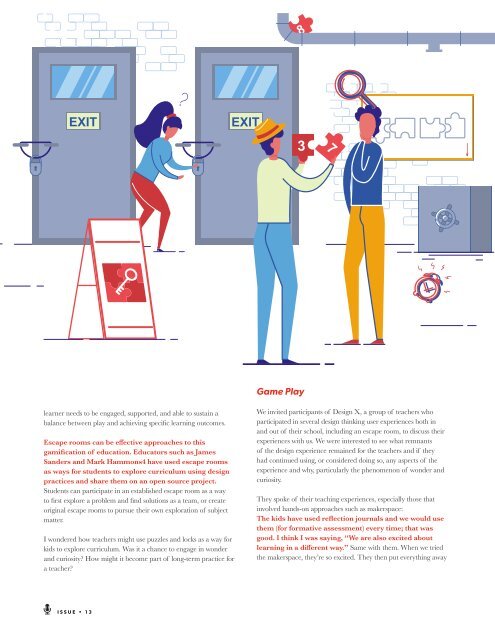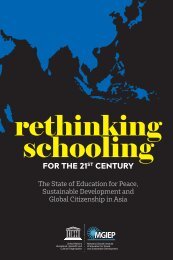The Blue DOT Issue 13
Reimagining Education: Beyond the Rhetoric
Reimagining Education: Beyond the Rhetoric
You also want an ePaper? Increase the reach of your titles
YUMPU automatically turns print PDFs into web optimized ePapers that Google loves.
learner needs to be engaged, supported, and able to sustain a<br />
balance between play and achieving specific learning outcomes.<br />
Escape rooms can be effective approaches to this<br />
gamification of education. Educators such as James<br />
Sanders and Mark Hammons4 have used escape rooms<br />
as ways for students to explore curriculum using design<br />
practices and share them on an open source project.<br />
Students can participate in an established escape room as a way<br />
to first explore a problem and find solutions as a team, or create<br />
original escape rooms to pursue their own exploration of subject<br />
matter.<br />
I wondered how teachers might use puzzles and locks as a way for<br />
kids to explore curriculum. Was it a chance to engage in wonder<br />
and curiosity? How might it become part of long-term practice for<br />
a teacher?<br />
Game Play<br />
We invited participants of Design X, a group of teachers who<br />
participated in several design thinking user experiences both in<br />
and out of their school, including an escape room, to discuss their<br />
experiences with us. We were interested to see what remnants<br />
of the design experience remained for the teachers and if they<br />
had continued using, or considered doing so, any aspects of the<br />
experience and why, particularly the phenomenon of wonder and<br />
curiosity.<br />
<strong>The</strong>y spoke of their teaching experiences, especially those that<br />
involved hands-on approaches such as makerspace:<br />
<strong>The</strong> kids have used reflection journals and we would use<br />
them (for formative assessment) every time; that was<br />
good. I think I was saying, “We are also excited about<br />
learning in a different way.” Same with them. When we tried<br />
the makerspace, they’re so excited. <strong>The</strong>y then put everything away<br />
and took a step back. . . . <strong>The</strong>y were thinking what they liked<br />
about this part or that game we tried, what was working well.<br />
I like the variety of approaches in the escape room. I have a box<br />
of locks and stuff and that is my beginning escape room. I got<br />
really excited about it and so I think it lends itself to what I am<br />
teaching this year—one is in social studies and (the other) in math.<br />
I think just being able to introduce it to them and then being like<br />
we are one of the explorers or in the middle of the fur trade . .<br />
. that is only one level of it and so I think I will definitely like to<br />
keep using it and see where it goes.<br />
How did the experience open up opportunities for wonder and<br />
curiosity? We asked about what evidence the teachers saw in the<br />
work itself or that was inspired by it later:<br />
I think that students were inspired in the escape room experience.<br />
<strong>The</strong>re were kids who are usually very quiet or reserved and<br />
they super excelled at the challenge. . . . Even kids who don’t<br />
necessarily work well in groups. . . . <strong>The</strong>y had to engage in a<br />
different way and they did. . . . We saw that in the makerspace<br />
later . . . in both places, you need to work as a team. Some even<br />
want to continue doing escape room parts in the next part of the<br />
research in social studies. <strong>The</strong>y just did not get sick of it. <strong>The</strong>y<br />
continued to be curious about the rooms and excited to do them<br />
again. . . . Even if they were completely wrong, it did not matter.<br />
Even when they knew they had already checked one pocket, they<br />
did it again, for the sake of their own curiosity. Even if 12 kids did<br />
it before them, they needed to satisfy that what they were looking<br />
for was not there. It just encouraged them to continue to try<br />
things later on.<br />
We also want to share this with colleagues. . . . I think being able<br />
to show them that it’s very reliable and then even just doing little<br />
bits of it, not necessarily making a huge escape room, but even . .<br />
REFERENCES<br />
1 Carson, R. (1956). <strong>The</strong> sense of wonder. New York, NY: Harper<br />
Collins.<br />
2 McWilliams, S. (1999, March). Fostering wonder in children:<br />
Baseline study of two first grade classrooms. Paper presented at<br />
Annual Meeting of the National Association for Research in Science<br />
Teaching, Boston, MA.<br />
. small things like QR codes, like we did for math, we collaborated<br />
and every one of our kids were around the school. . . . I don’t<br />
think it needs to be this big elaborate project. It can be the little<br />
things . . . the students have commented that they can have a little<br />
escape room at their desks by just using or planning a puzzle. If<br />
you finish the puzzle, you can challenge your friend . . . you can<br />
have the pieces all over the room. It just makes learning more<br />
interesting for the kids.<br />
We saw aspects of gamification transforming the learning<br />
experiences for both the teachers and the students in the<br />
classrooms; perhaps they were being freed from the curriculum in<br />
new ways. We wondered what this meant to the teachers:<br />
A game doesn’t have a limitation. You can do a lot of<br />
things when you play, everybody can get it and find a<br />
place and it’s not just about the individual person, it’s<br />
about when you play and you can see so much learning<br />
going on. I think the kids know it too and it’s very<br />
powerful . . . they ask all the time, “Can we play that<br />
again?” Now, I just give them the chance to try out new<br />
games or even better, make them themselves using<br />
puzzles.<br />
Through the escape rooms, students are taking charge with a<br />
classroom activity that looks like fun but is truly engaged learning.<br />
Providing students with opportunities to experience<br />
learning through games, such as escape rooms, puzzles,<br />
and scavenger hunts, brings wonder and curiosity back<br />
into the classroom. L’Ecuyer suggests that “wonder is the<br />
center of all motivation and action in the child. Wonder and<br />
beauty are what makes life genuinely personal. Wonder attunes<br />
to beauty through sensitivity . . . when wonder, beauty, sensitivity<br />
and secure attachment are all present, learning is meaningful.”4<br />
3 Kapp, K. M. (2012). <strong>The</strong> gamification of learning and instruction:<br />
Game-based methods and strategies for training and education. San<br />
Francisco, CA: Wiley and Sons. p. 10.<br />
4 L’Ecuyer, C. (2014). <strong>The</strong> wonder approach to learning. Frontiers in<br />
Human Neuroscience, 8(764), 1-8. p. 6.<br />
ISSUE • <strong>13</strong><br />
3 5

















